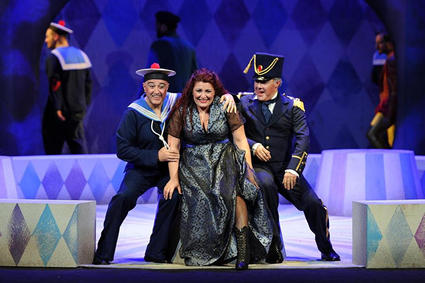| Opera Reviews | 19 April 2024 |
A sparkling, witty Fille du régiment in Salernoby Lorenzo Fiorito |
|
| Donizetti: La fille du régiment
Teatro Municipale Giuseppe Verdi, Salerno 14 April 2019 |
|

Gilda Fiume (Marie), Ensemble
|
|
|
Riccardo Canessa’s production of Donizetti’s La fille du régiment¸ which opened the opera season at the Teatro Verdi in Salerno, was full of humour and invention, with a refined staging and a clever use of parody. A very entertaining production, indeed, with wonderful music and some of the most celebrated bel canto showpieces. Donizetti’s comic masterpiece is a concentration of spirit, liveliness and elegance, combining genuine Italianate melody and French musical finesse. The score is interspersed with witty spoken dialogue and includes sparkling soldierly songs - “Chacun le sait” is particularly famous - and pitiful arias, such as Marie's “Il faut partir” and Tonio's “Pour me rapprocher de Marie”. The most famous piece is Tonio's “Pour mon âme”, a bravura aria in which the tenor is required to sing nine high Cs in sequence. The action was updated by the director to the end of the 19th century; the first act was set in the port of Salerno, while in the second act the castle of the libretto became a circus managed by the Marquise of Berkenfield, with clowns, acrobats and jugglers. Accordingly, scenes and costumes by Flavio Arbetti were an explosion of colours. Canessa imposed a fast theatrical rhythm to his staging: military parades, boxing sessions between Marie and Sulpice, performances by acrobats in the circus. Also, some details of the libretto were changed (Tonio is indicated as being from Salerno). The production is well choreographed too: Canessa pays constant attention to the movements of the principals and chorus. The soldiers (but here they are sailors) of the 21st Regiment and the circus crew move tirelessly on the small stage. Soprano Gilda Fiume created a delicious contrast between Marie’s tough tomboy exterior and the coloratura girly girl she is inside, stomping around emitting vintage trills, scales and staccati delicate as point d’esprit. Her timbre was rich and even throughout her range and the singing lines were clear and well phrased. Shalva Mukeria was well suited for the role of Tonio, and his aria “Pour mon âme“ was excellently sung, with great confidence and ardour. Mukeria's sound was well projected, his register stunning for both solidity and intonation. Filippo Morace portrayed Sulpice with intelligence and musicality, spreading humanity and paternal affection. The expert bass baritone was also impeccable in the spoken parts. Perfectly adhering to the part, Claudia Marchi’s Marquise de Berkenfield, who turns out to be Marie's mother, was witty and funny in the second act, in pyrotechnic comic dialogue scenes. Claudio Levantino was a Hortensius with a sound voice and correct acting. Other minor roles were all well sung. Canessa’s sprightly staging was paralleled by the clean and fizzy conducting of Antonello Allemandi, that added vitality, humour (and martial tone when needed) to the score. There was a sense of delight in the march rhythms and a contagious air of fun shining through it all. The "Giuseppe Verdi" Orchestra was ductile and precise, while the choir, well prepared by Tiziana Carlini, sang confidently as usual offering a round and powerful sound.
|
|
| Text ©
Lorenzo Fiorito Photo © Massimo Pica |
|







